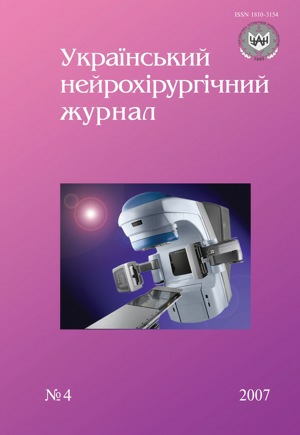Modern technologies of neuromonitoring with intracranial hemorrhage
DOI:
https://doi.org/10.25305/unj.112367Abstract
No abstract.References
Гайдар Б.В. Практическое руководство по транскраниальной допплерографии / Под ред. Б.В. Гайдара, В.Е. Парфенова, Д.В. Свистова. — СПб.: ВМедА, 1994. — 186 c.
Лебедев В.В., Куксова Н.С., Крылов В.В., Мятчин М.Ю. Информативность ЭЭГ в остром периоде субарахноидального кровоизлияния вследствие разрыва внутричерепных церебральных аневризм // Вопр. нейрохирургии. — 1989. — №5. — С.44–49.
Dearden N.M. Jugular bulb venous oxygen saturation in the management of severe head injury // Curr. Opin. Anaesth. — 1991. — V.4. — P.279–286.
Engstrm M., Polito A., Reinstrup P. et al. Intracerebral microdialysis in severe brain trauma — the importance of catheter location // J. Neurosurg. — 2005. — V.102. — P.460–469.
Hillman J., Aneman O., Andersson C. et al. A microdialysis technique for routine measurement of macromolecules in the injured human brain // Neurosurgery. — 2005. — V.56. — P.1264–1270.
Kety S.S., Shmidt C.F. The nitrous oxide method for the quantitative determination of cerebral blood flow in man: Theory, procedure, and normal values // J. Clin. Invest. — 1948. — V.27, N4. — P.476–483.
Latronico N., Beindorf A.E., Rasulo F.A. et al. Limits of the intermittent jugular bulb oxygen saturation monitoring in the management of severe head trauma patients // Neurosurgery. – 2000. — V.46. — P.1131–1138.
Nylin G., Helund S., Regnstrom O. Cerebral circulation studied with labeled red cells in healthy males // Acta Radiol. — 1961. — V.55. — P.281–304.
Prognosis of severe traumatic brain injury. Part 1: Guidelines for the management of severe traumatic brain injury. Brain Trauma Foundation. // J. Neurotrauma. — 2007. — V.24, Suppl. 1. — P.1–106.
Reed R. Mixed venous saturation as a «stand-alone» indicator of the oxygen extraction ratio // Intern. J. Intens. Care. — 2004. — V.11, N3. — P.103–108.
Robertson C.S., Narayan R.K., Gokaslan Z.L. et al. Cerebral arteriovenous oxygen difference as an estimate of cerebral blood flow in comatose patients // J. Neurosurg. — 1989. — V.70. — P.222–230.
Stocchetti N., Paparella A., Bridelli F. et al. Cerebral venous oxygen saturation studied with bilateral samples in the internal jugular veins // Neurosurgery. — 1994. — V.34. — P.38–43.
Valadka A.B., Gopinath S.P., Contant C.F. et al. Relationship of brain tissue pO2 to outcome after severe head injury // Crit. Care Med. — 1998. — V.26. — P.1576–1581.
Downloads
Published
How to Cite
Issue
Section
License
Copyright (c) 2007 S. S. Petrikov, V. V. Krylov

This work is licensed under a Creative Commons Attribution 4.0 International License.
Ukrainian Neurosurgical Journal abides by the CREATIVE COMMONS copyright rights and permissions for open access journals.
Authors, who are published in this Journal, agree to the following conditions:
1. The authors reserve the right to authorship of the work and pass the first publication right of this work to the Journal under the terms of Creative Commons Attribution License, which allows others to freely distribute the published research with the obligatory reference to the authors of the original work and the first publication of the work in this Journal.
2. The authors have the right to conclude separate supplement agreements that relate to non-exclusive work distribution in the form of which it has been published by the Journal (for example, to upload the work to the online storage of the Journal or publish it as part of a monograph), provided that the reference to the first publication of the work in this Journal is included.









